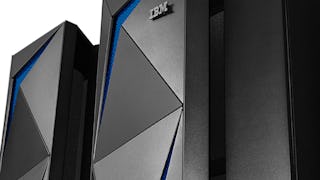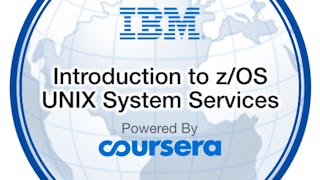This course is designed to provide the SMP/E skills needed in the installation and maintenance of optional features and maintenance in the z/OS operating environment. Students are taught to define the SMP/E database and invoke SMP/E to add, modify, or replace system elements. The course includes extensive hands-on labs using a current level of SMP/E. Students will get practical experience in the SMP/E tasks involved in installing a z/OS product. Emphasis is on interpreting results of SMP/E processing. SMP/E concepts examined in this course include modification control statements, the consolidated software inventory, zone structure, and error analysis. SMP/E commands such as RECEIVE, APPLY, ACCEPT, RESTORE, REPORT, and LIST are discussed. Students will also learn how to perform automated SMP/E delivery of z/OS and product maintenance over the Internet with an automated SMP/E process that downloads and installs IBM preventive and corrective service over the Internet.

Unlock access to 10,000+ courses with Coursera Plus. Start 7-Day free trial.

Recommended experience
Skills you'll gain
Details to know

Add to your LinkedIn profile
9 assignments
See how employees at top companies are mastering in-demand skills

There are 12 modules in this course
SMP/E is a tool designed to manage your z/OS operating environment. It is capable of ensuring the proper installation of products and maintenance in a complex environment, so it is no surprise that the tool itself is complex. This unit presents the basic terms and concepts associated with SMP/E to give you a foundation on which to build understanding of a product that has many closely interrelating parts. This unit assumes some knowledge of basic z/OS facilities. If you are unfamiliar with some of the z/OS terminology used here, please refer to the glossary after the Appendix B of this student guide.
What's included
7 videos1 assignment
SMP/E SYSMODs contain both the modification text and a set of instructions that advise SMP/E exactly how the modification is to be used. These instructions, called modification control statements (MCS) contain the details of how and where the SYSMOD is to be installed. In this unit, you will examine MCS as well as the three techniques used to package SYSMODs.
What's included
5 videos
One of the primary responsibilities of SMP/E is to keep track of SYSMODs that are installed on your system. SMP/E ensures that all SYSMODs affecting a given element are installed in the proper sequence. Element regression does not occur if the SYSMODs are installed in the correct order. This order is determined by the packager and is communicated to SMP/E through the modification control statements. This unit explains how SMP/E tracks the SYSMOD level of an element. Why tracking is so important and the details involved are both discussed in the APPLY processing unit.
What's included
1 video1 assignment
The consolidated software inventory contains information necessary for all SMP/E processing. It describes how a given set of system libraries is built so SMP/E knows how to add to and modify those libraries.
What's included
5 videos1 assignment
SMP/E can be invoked either by using the dialogs (which generate JCL) or by submitting batch jobs containing JCL. This unit examines SMP/E JCL. Specifically, we will look at the required DD statements necessary to process various commands. SMP/E also provides the ability to have the required data sets dynamically allocated when needed. The methods and advantages to dynamic allocation will also be discussed in this unit.
What's included
2 videos
Tasks involved in maintaining the currentness of a system include the installation of SYSMODs. The first step in the installation is the RECEIVE process which stages SYSMODs into the SMP/E database. This unit examines the RECEIVE process. Also discussed is the REJECT command which reverses the results of RECEIVE.
What's included
4 videos1 assignment
The APPLY command is used to install elements supplied by a SYSMOD into the target system libraries. The APPLY process selects SYSMODs in the global zone based on operands coded on the APPLY command as well as their applicability to the environment. SMP/E also ensures that all requisite SYSMODs are applied or are being applied concurrently. It invokes system utilities to install the elements into the target libraries and records the new element's level in the target zone. This unit examines each of these phases in detail as well as the various operands that can be specified on the APPLY command.
What's included
7 videos1 assignment
The ACCEPT command is used to cause SMP/E to install the elements supplied by a SYSMOD into the distribution libraries. This master copy of elements is used when SYSMODs, installed on the target system, must be RESTOREd. They also serve as a base from which your installation can perform a system generation.
What's included
2 videos
RESTORE reinstalls the distribution library level of an element into the target library. It is a process that can be used to remove installed SYSMODs that have not been accepted.
What's included
1 video1 assignment
This unit addresses the commands that relate more closely to product build activities, BUILDMCS, LINK LMODS, and LINK MODULE.
What's included
3 videos
Students will examine the processes of both LIST and REPORT. The LIST command is used to gather information about the entries of one or more zones. It is the batch mode equivalent of the QUERY function in the SMP/E dialogs. The REPORT command is used to obtain information about SYSMODs which have been installed on your system.
What's included
3 videos1 assignment
In SMP/E V3.5, a major new function called RECEIVE ORDER allows for a completely automated SMP/E process that downloads and installs IBM preventive and corrective service over the network or Internet.This unit looks at SMP/E V3.6 which is a base component of z/OS, and which packages support for the electronic delivery of a Service over the network or Internet. In z/OS, a new type of package called an ORDER enables SMP/E to automatically order and install maintenance over the Internet.
What's included
3 videos2 assignments
Instructor

Offered by
Explore more from Software Development
 Status: Preview
Status: Preview Status: Free Trial
Status: Free Trial Status: Free Trial
Status: Free Trial Status: Preview
Status: Preview
Why people choose Coursera for their career





Open new doors with Coursera Plus
Unlimited access to 10,000+ world-class courses, hands-on projects, and job-ready certificate programs - all included in your subscription
Advance your career with an online degree
Earn a degree from world-class universities - 100% online
Join over 3,400 global companies that choose Coursera for Business
Upskill your employees to excel in the digital economy
Frequently asked questions
To access the course materials, assignments and to earn a Certificate, you will need to purchase the Certificate experience when you enroll in a course. You can try a Free Trial instead, or apply for Financial Aid. The course may offer 'Full Course, No Certificate' instead. This option lets you see all course materials, submit required assessments, and get a final grade. This also means that you will not be able to purchase a Certificate experience.
When you purchase a Certificate you get access to all course materials, including graded assignments. Upon completing the course, your electronic Certificate will be added to your Accomplishments page - from there, you can print your Certificate or add it to your LinkedIn profile.
Yes. In select learning programs, you can apply for financial aid or a scholarship if you can’t afford the enrollment fee. If fin aid or scholarship is available for your learning program selection, you’ll find a link to apply on the description page.
More questions
Financial aid available,

